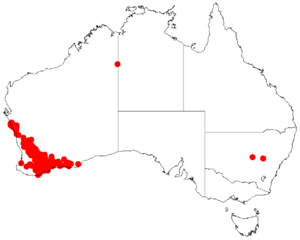Acacia bidentata facts for kids
Quick facts for kids Acacia bidentata |
|
|---|---|
| Scientific classification | |
| Genus: |
Acacia
|
| Species: |
bidentata
|
 |
|
| Occurrence data from AVH | |
Acacia bidentata is a type of shrub that belongs to the large plant group called Acacia. It is found naturally in Western Australia.
What Does It Look Like?
This plant is a low-growing shrub that often forms a rounded shape, like a small dome. It usually grows between 0.1 and 1 meter (about 4 inches to 3 feet) tall. Its small branches are a dusty white color. It has tiny, hard-to-see leaf-like parts called stipules.
The leaves of Acacia bidentata are not true leaves but flattened leaf stems called phyllodes. They are shaped like an upside-down egg or a triangle, usually 4 to 7 millimeters (about 0.16 to 0.28 inches) long and 2.5 to 5 millimeters (about 0.1 to 0.2 inches) wide. These green phyllodes can be smooth or have tiny hairs along their edges.
The plant blooms from July to October. It produces white, cream, or yellow flowers. Each flower cluster, called an inflorescence, has one to three round or oval-shaped heads. These heads contain 10 to 16 creamy white or pale yellow flowers that are not packed very tightly together.
After the flowers, the plant grows strong, curved seed pods. These pods are about 15 millimeters (about 0.6 inches) long and 3 to 4 millimeters (about 0.12 to 0.16 inches) wide. Inside the pods are oblong-shaped seeds, each about 3 to 3.5 millimeters (about 0.12 to 0.14 inches) long.
How It Was Named
This plant was first officially described in 1842 by a botanist named George Bentham. He included it in a book called Notes on Mimoseae, with a synopsis of species, which was part of William Jackson Hooker's London Journal of Botany.
For a short time in 2003, it was given a different scientific name, Racosperma bidentatum, by Leslie Pedley. However, in 2006, it was moved back to its original group, the Acacia genus.
Where Does It Grow?
Acacia bidentata is found naturally in several areas of Western Australia. These areas include the Mid West, Wheatbelt, and Great Southern regions.
It grows in different places, from Kalbarri in the north, south around Carnamah. Most of these plants are found south of Carnamah, reaching down to Stirling Range National Park in the south and east towards Grass Patch.
This plant can grow in various types of soil, including clay, sand, sandy loam, gravelly loam, and loamy soils. It is often found in areas with mallee woodlands and heath communities.

